|
|
Straight into the Sun Entire frame (upper panel) and crop shown at 100% (actual pixel size, no sharpening applied)
|
| Nikon D200 Digital Camera Reviewed | |
| by Bjørn Rørslett | |
5.
Noise Performance and Image Imperfection Issues
Digital image noise might be obtrusive, but a virtually noiseless digital image can in fact be perceived as cold and sterile. Thus, not all kinds of noise are bad as far as photography is concerned. Just rewind your memory to the old glorious days of souped Tri-X when megagrain (not megapixel) was in the vogue.
I think we quite easily accept some noise in the images when that noise manifests itself sufficiently randomly, in nature as well as in its spatial distribution. Visual patterns of noise, and in particular colour banding or striping of the image, are far more objectionable. Unfortunately, the artificial kind of noise we have seen in the past with many DSLRs (from Nikon and their competitors as well) has earned the notion of digital noise a bad reputation in some photographic circles. In a manner of speaking, such noise detracts from the image content in the way that poor digital records grate on the ear.
Underutilization of the dynamic range of the digital imager is a major candidate for noise generation. This occurs either by user error (severe underexposure) or by deficiencies in the metering system of the camera emphasizing highlights instead of shadows when scene contrast is high. I believe the matrix metering system of D200 tries to prevent highlights from blowing out and thereby sometimes allows the shadows to get too dark. The end result is an image with perfect highlights and shadows in which traces of colour noise can appear. The cure for this is simply to expose a little richer, or thinking about how you did shoot negative instead of slide film in the dark ages so many moons ago.
Automatic white-balance is another less readily recognised culprit causing digital noise. We have become sloppy technicians preferring to click a button in software to get a "white" rendition instead of attaching a colour-balancing filter to the lens. Thus when shooting under incandescent lighting and setting the colour balance by automatic means, we are (but shouldn't be) surprised and annoyed by appearance of blue-channel noise and don't consider the tremendous additional boost of blue colours needed to balance a blue-deficient light (incandescent light) as white. If you combine incandescent light sources with severe underexposure, the end result will show visible blue channel noise. Obviously you should have such results, but still some people need to be reminded of facts before they start complaining about camera "flaws".
A final way of avoiding noise is to max out aperture (and/or shutter speed) before you dial in a higher "ISO" setting on the camera.
So, let's investigate various aspects of the image rendition of D200. First off, the issue of "blooming", which can result from massive overexposure of the imager, typically when you shoot into the sun. With a camera such as the D70, blooming could be a nasty issue unless you followed the practice of stopping the lens down and setting the exposure to the lean side. Longer lenses tend to exacerbate the blooming issue by their very nature of compressing and enlarging distant subjects such as the sun, so the general recommendation is never shoot into the sun. Accordingly, I did exactly this with my longest lens, the cannon-calibre 1200 mm Nikkor, and here is the result,
|
|
Straight into the Sun Entire frame (upper panel) and crop shown at 100% (actual pixel size, no sharpening applied)
|
I consider the "blooming" issue to be largely non-existent with the D200. This welcomed trait implies you can include bright spots of light in your images without fear of getting image anomalies. In fact D200 behaves at least as good as the D2X in this respect.
By the way, shooting into the sun is something you should do with great care: your eyes may not like the intense glare any more than does the imager in the camera. If you shoot into the sun (typically with wide-angle lenses), always remember to stop down to the smallest aperture value available on your lens. The exception to this rule is when you shoot with telephoto lenses, a situation in which you normally wish to have the solar disc as large as possible, and hence should set the lens to be wide or nearly wide open (if the lens is focused on infinity, the aperture really doesn't matter, though). However, don't ever try to do this unless the sun is just about to set, or is enshrouded in a thick cloud layer as in the above shot. Here I realised the sun was just about to break through the heavy cloud banks, so moved my eye from the finder and waited a few seconds for the sun rays to burst forth.
A significant claim made by Nikon in defense of their smaller-sized "DX" format is that DX lenses mitigate issues such as light fall-off in the corners and the ills of chromatic aberration. I found virtually no signs of light fall-off for any of my DX-type lenses, so the claims seem corroborated for field shooting. However, CA is a nasty and persistent optical gremlin, and in fact, CA issues hardly visible with the D1X or its ilk became plainly visible with the D200 (or D2X), if the image is scrutinised under high magnification. Thus, higher resolution doesn't come free. Still, a proper perspective needs to be upheld. For many purposes, the CA wouldn't show up in print, or it can be reduced by further post-processing steps. Nikon Capture and Photoshop ACR incorporate tools for automatic reduction of CA. But of course the less CA there is from the start, the less the need to bother with it at all.
| Example of Chromatic aberration (CA) - I | |
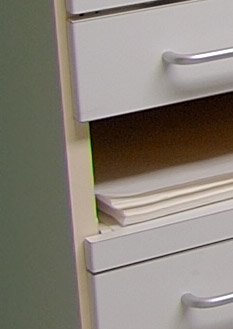 © Ola-E. Hofshagen |
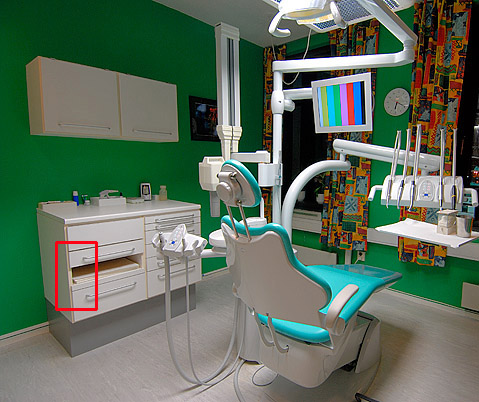 |
| (you'd never guess he's a dentist, would you?) | D200 with 12-24 DXNikkor |
Vestiges of chromatic aberration (CA) can be seen on the crop to the left. Red/green or purple/cyan fringes are the common expressions of CA. Is this amount of CA important? The answer certainly depends on the ways in which the image should be used, so a reduction of CA may be needed for an exhibition print, but not for prints in newspapers or magazines. For web use the CA issue is purely academic. |
|
My observations on lens performance with the newer, high-resolution DSLRs such as D200 (and D2X) are continuously being added to the lens review pages. An initial and interesting observation is that AFS 17-35/2.8 Nikkor, not a DX-type design, showed equal or less issue with CA at its 17 mm setting than did the AFS 17-55/2.8 DX Nikkor. Another finding is that several of my trustworthy long lenses, such as for example the AIS 300 mm f/2.8 or AIS 300/4.5 ED-IF Nikkors, exhibited far more visible CA with the D200 than with any of the D1-series cameras I've used them on earlier. Telephoto lenses originating in the early '80s often had a basic design comprising 8 elements in 6 groups, and I fear the chromatic correction of these lenses even with all their ED glass is insufficient to cope with the more stringent demands of the high-resolution D200 imager.
| Example of Chromatic aberration (CA) - II | |
|
|
D200 with 400 mm f/3.5 ED-IF Nikkor |
|
| Everything looks spic and span and winterly fresh, until we zoom into the image to give a 200% crop, (below). This lens show the alternate, purple/cyan colour pattern of chromatic aberration (CA), and its CA becomes quite obvious when used on the D200. | |
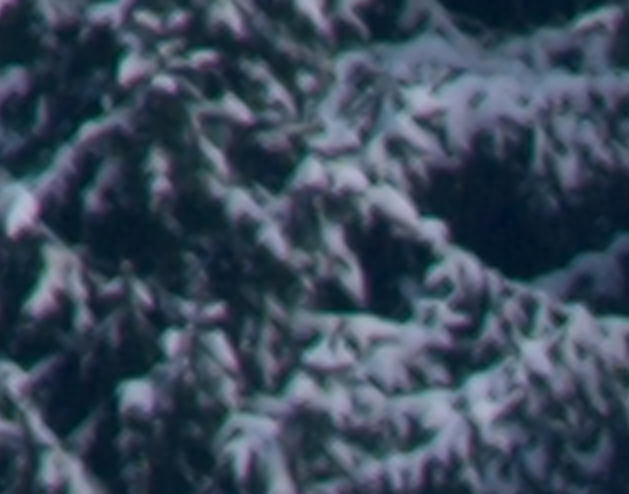 |
|
In contrast, my more recent AFS telephoto lenses (for example, AFS 300/2.8 Mk.I and AFS 200/2 VR Nikkors) behaved much better on the D200, as they do on the D2X. My venerable travelling companion, the 50-300 mm f/4.5 ED Zoom-Nikkor, performed very well on the D200, again as on the D2X, up to the long end, which showed some increase in CA. On the other hand, my 14 mm f/2.8 Nikkor,although sharp, simply had too much colour fringing in the corners for my taste. Even the old-time favourite 28 mm f/2 AI fared likewise. So, many lenses are unmasked by the D200, and some will give pleasant surprises.
5.3. ISO noise
The final issue to be addressed is that of "ISO" noise. For some strange reason, inscrutable in an almost Oriental fashion, photographers (or more likely, gearheads masquerading as photographers) have become obsessed with "noise" at astronomically high ISO speeds, even if these are outside the approved camera settings. Each to his own, but I frankly cannot see the relevance for some of these heated debates. People should try faster lenses or make other improvements to their technique before complaining about noise at 3200 ISO equivalency. Or try 3200 ISO film - that'll teach them a lesson in what's relevant. Off the soap-box, back to the review.
The D200 has a nominal ISO equivalency range of 100-1600, and additionally a HI-1* setting. The pixel pitch of the D200 is about 6.05µm (1µm = 1/1000 of a millimetre; many bacteria are much bigger than this), while the D2X imager is 5.5 µm. From earlier test series, we know the D2X is a very decent performer at least up to 400 and given proper treatment, to 1600 as well. So we would expect the D200 to perform at least to this level.
*The HI-1 isn't calibrated by Nikon, so the factory won't guarantee it is truly one stop faster than the 1600 ISO equivalency.
The statistics I derived for ISO noise are displayed on the graph below, indicating that the D200's noise level is kept under quite strict control. Despite its smaller pixel pitch, the D2X performs nearly as well as the D200, and both are better than the D70 and D2H (not shown). The camera has user-selectable "HI ISO" noise reduction settings, where you can set NR to "Off", "Normal", or "High". I was in the first round of tests a little baffled by these settings because my results were inconsistent and the converting software evidently influenced the end result. The results below were obtained using BibblePro 4.5 as the NEF converter, to allow the inherent noise to show better since Bibble doesn't obey the instruction set embedded in the NEF by the camera. In contrast to the D2X, you can set intermediate 1/3 EV values in the 800 - 3200 "ISO" range. These are 1000 and 1250 below 1600, and Hi +0.3 and +0.7 for the non-calibrated 1600-3200 range.
|
|
| Measured image noise
from the D200 and D2X run across the entire ISO range of
each camera. Standard deviation measured on (RGB) data on
concurrently taken images under "real world"
conditions, with the AFS 300/2.8 lens at f/5.6, Hi-Iso NR
set to "Normal" which is the default. The non-calibrated 3200 ISO setting on D200 occurs as "HI" in menus and in LCD displays. The EXIF output in Nikon Capture 4.4 likewise simply states "1 stop above ISO 1600". With the D2X, 800 ISO equivalency is the highest calibrated setting, and 1600 and 3200 "ISO" are denoted "Hi-1" and "Hi-2", respectively. Third-party raw file converters designate the non-calibrated values with the traditional "ISO" values (1600 and 3200). |
You are entitled to draw your own conclusions of course, but I for one won't hesitate upping the "ISO" equivalency if needs so dictate. The foundation for this is shown below. Nikon has designated the upper level as "HI" and won't assign an "ISO" number to this uncalibrated setting, and the test images do show it is more noisy than the approved range of 100-1600 "ISO". However, image detail is sharply rendered and the noise can be mitigated to some extent by dedicated noise-removal software.
As you increase the ISO equivalency, the image becomes a trifle noiser, and from 800 ISO and up, a steady rise in the loss of shadow detail is evident. Colour rendition gets more muted on the "Hi" ISO settings, too. Still, the image quality achieved in the non-approved "HI" range ( 3200 "ISO") is perfectly usable for a great number of assignments.
If you run the NEFs through Nikon Capture (4.4) you can switch off the additional noise reduction that you have selected in-camera. This option is (by intent?) made quite inaccessible and every time a new image loads, it defaults to NR 'On' again. If you shoot NEF + jpg (Fine), or process your NEFs by other means than Nikon Capture, this allows you to see the tremendous amount of noise reduction taking place along the pipeline. Concurrently, details are lost. In effect, you trade lower noise for lower sharpness. Up to 800 ISO, this loss is scarcely noticeable, but at the higher speed settings, this isn't so any more.
The interplay between the camera, file formats (NEF vs jpg), different pipelines for image processing, and different destinations for the final images (web, magazines, books, newspapers) is exceedingly complex, and you can get almost the result you want. Is it appropriate, or even relevant, to call a camera "noisy" at a particular ISO setting if the noise can be abated by downloading jpgs instead of NEFs from the camera, or the NEF files run though another raw converter, or the image is to be printed or viewed at less than gallery-sized prints so any noise would hardly be perceived? Or even more peculiar to the time we live in, comparing cameras at ISO settings outside the calibrated range of the manufacturer? The entire "noise" discussion is getting out of hand and losing scope. Have the lessons and experience with fast films already been forgotten? I think it's timely to address the "noise" of current digital cameras within the proper framework. True, we do need raw speed sometimes, but for most of those applications the emphasis is on the image and its story, not the possible lack of gallery print quality. There are tripods and fast lenses to help solve many practical situations instead of maxing out the ISO setting. Compared to what film could deliver, we get superlative high-ISO images from virtually any DSLR on the market today.
|
|
| This idyllic
homestead, located on Maridalsvann lake just a few
minutes away from my home, is amongst my standard test
motifs. The shooting distance is exactly 2 km so I tend
to deploy a 300 mm or longer lens, here an AFS 300 mm
f/2.8 Nikkor. To satisfy the silliness of the mad pixel-peeping crowd, I'll show a number of variations on the 3200 "ISO" (HI-1) test image. Observe this is the identical NEF file, just processed differently. Also, this high-ISO setting isn't even calibrated, just offered as a last-ditch resource if you are desperate enough to need it. You are now looking at the equivalent of 20 x 30" prints at close range. Trade some sharpness for less noise, or vice versa, but any of these variations shows how good the image quality of D200 really is. |
|
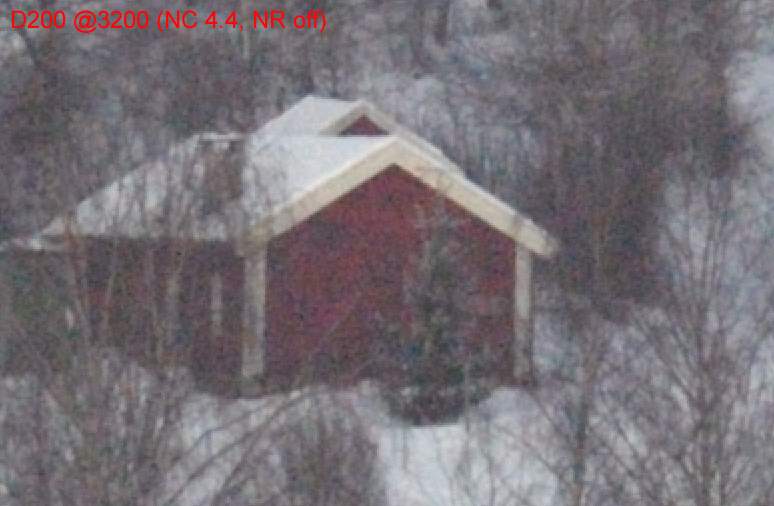 |
|
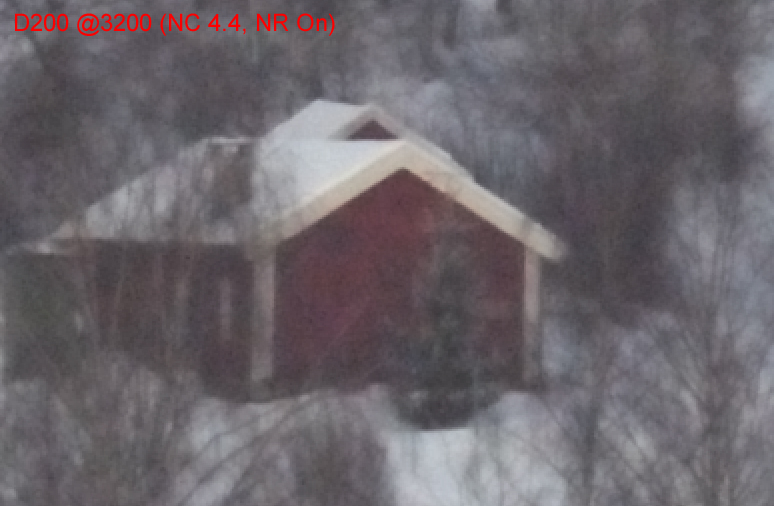 |
|
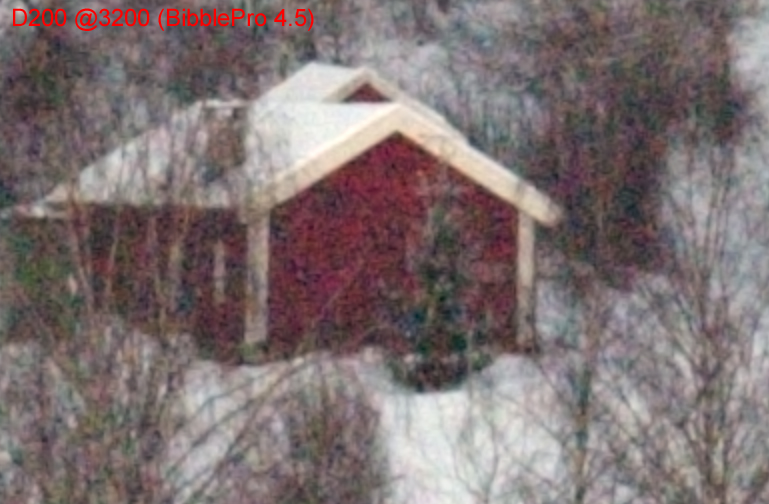 |
|
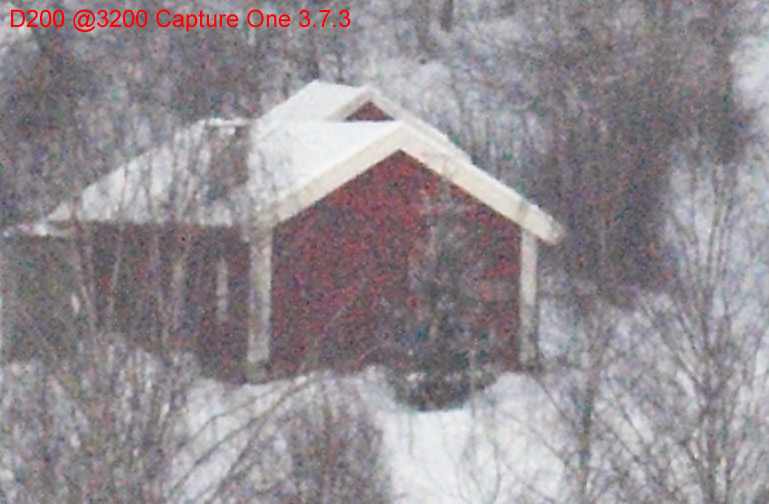 |
|
| Just to give the reference, this is the baseline 100 ISO image | |
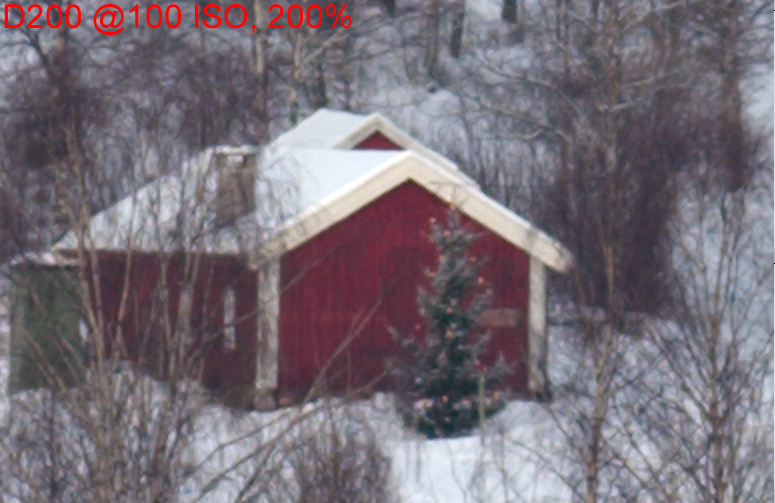 |
5.4. The "Striping" Issue
A hotly debated topic on various web sites has been the sporadic occurrence of regular artifacts, or a striping* pattern, achieved with some D200 cameras. The striping** is vertically oriented only and deviates strongly from the more irregular, noise-filled horizontal patterning you can observe with say an underexposed image taken with a D1X or D70 camera.
* I prefer to designate this
"striping" rather than "banding", since it is
mainly a luminance issue.
**Vertical or parallel to the minor axis with reference to the
CCD, so you will see the striping horizontal in a portrait-mode
shot
I have identified three different kinds of striping, such as they appear visually. Now, I do not know whether they all originate from the same source. In fact, I haven't any inside information about the underlying cause(s). All I do know is that with some cameras, we see a real, existing issue. Is it serious? Maybe not on a general level, but a troubled camera could be annoying for some shots, more so because the presence of striping seems to be very unpredictable. Now you see it, now you don't. However, when striping does occur, it typically is one of the following,
Affected cameras show all three clearly, depending on the shooting circumstances, while a non-affected camera has none or only the most minute vestiges of (I), no (II), and only traces of (III) in conjunction with colour noise in greatly underexposed pictures. So, the main message here is that if you need to torture and abuse your NEF file to get visible striping, the camera probably should be OK. Another point is that most problems occur with images having high contrast or blown highlights, but this isn't a prerequisite. The final point is that you may see issues with jpgs straight off the camera, but not always on the output processed NEFs.
Striping of various kinds has been seen at most ISO speed (at least up to 1250) or aperture settings of the camera. This is not something you can eliminate just by stopping down or changing ISO. What do these various kinds of striping look like?
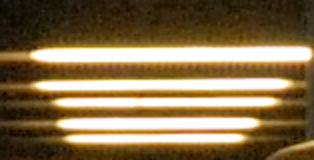 "©" Bjørn Rørslett-NN/Nærfoto |
|
| Type I
Striping forms a comb-like pattern
surrounding intense highlights such as fluorescent tubes.
The stripes extend only a short distance and hence their
spatial distribution is limited. This is not a diagnostic
for a flawed camera, since even fully functional units
can show the occasional traces of this kind (I). Thus, I shot more than 9,000
exposures with my review sample before I could identify a
vestige of this pattern. |
|
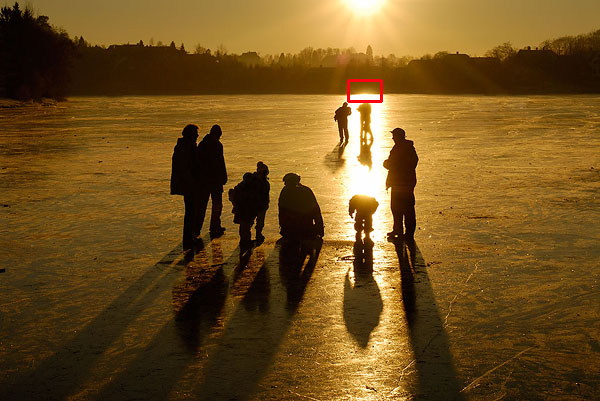 |
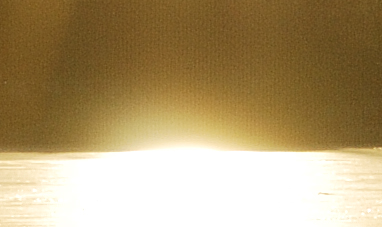 "©" Ola-E. Hofshagen |
| Type II
Striping is seen extending all over the
shadows or middle toned areas, typically when the scene
has strong or blown highlights. This is the image from a
faulty camera. |
|
|
|
| When it occurs on a
subject with normal lighting and the exposure is spot-on,
type III Striping may be the most
troublesome variety, The impression is of an interference
pattern of some kind. Most strange. If you shoot a
"normal" lit subject and get a result like the
above, your camera definitively malfunctions. |
|
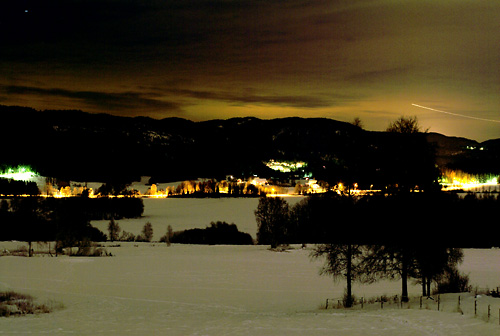 This kind of striping is also seen in night scenes. Now, night shots tend to be high-contrast and the dynamic range extensive. If you expose for best highlight and do want the scene to look darkish, such as the night itself, you get an image like this, which has a significant degree of striping (III) all over the frame and plenty of colour noise. Exposure is 30 secs, and the curves have been strongly lifted during post-processing. "©" Bjørn Rørslett-NN/Nærfoto |
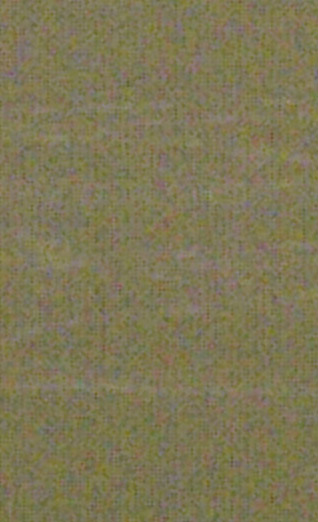 |
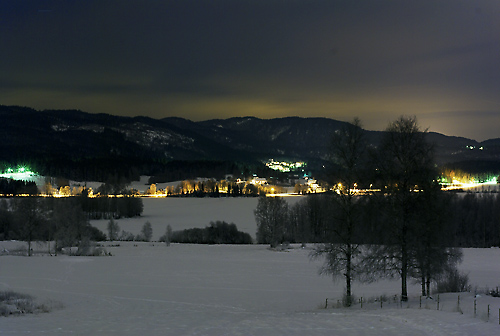 Increasing the exposure some 4 stops, from 30 secs to 9 minutes, renders the ground with more detail, yet keeps much of the dark, sombre character of the scene. Overall colours are more pleasan,t and the intensity of striping (III) is now grteatly reduced. So, for "normal" cameras we see that geting a proper exposure for high-contrast shots is a way of mitigating any striping. We might simply be observing noise patterns generated from a limited dynamic range.
|
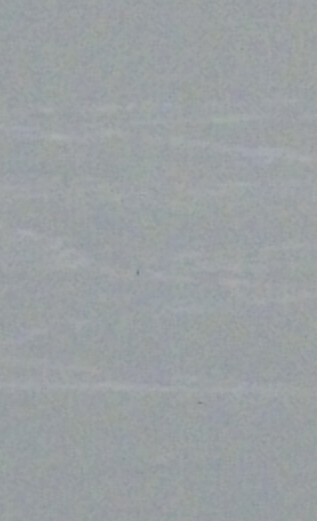 |
I shot more than 9,000 exposures with my review sample before I could identify a vestige of Type (I) striping. A friend encountered issues within the first hundred shots.